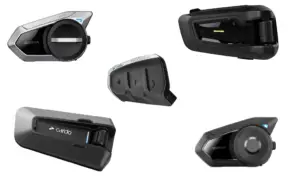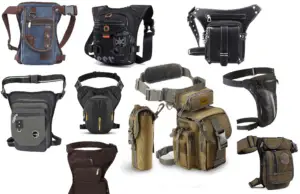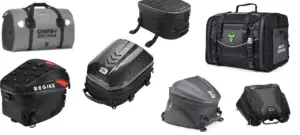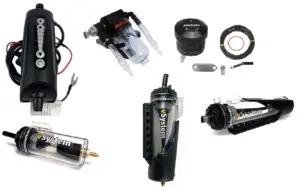The article reviews 4 popular Lithium battery manufacturers – NOCO, Antigravity, Shorai, and WPS – along with information on their products.
Long Story short – always choose a Lithium battery with a Battery management system (BMS).
Secondly, to ensure your battery can crank your engine, check the CCA (Cold Cranking Amps) rating. For engines with a large capacity (over 1200cc), it is recommended to choose a battery with a CCA of 300 or higher. For mid-capacity engines (500-1200cc), a CCA of 200-250 should do the job. If your engine has a capacity of under 500cc, you can choose a smaller battery to save weight.
NOCO and Antigravity batteries are the best on the market. I would go with NOCO NLP20 for a Large engine Cruiser. For a larger-capacity adventure bike – Antigravity AT12-BS is an optimal choice. Smaller adventure bike – NOCO NLP14. For a Dual-Sport both ATZ7 and NOCO NLP5 are good choices to save weight.
Best For Cruisers
Li-ion type: LiFePO4
BMS: ✔️Dynamic BMS
Capacity: 7Ah (84 Wh)
Starting Current: 600A
Charge Cycles: 2000
Size(LxWxH): 175x87x130 mm
Weight: 1.7Kg (3.7 Pounds)
For ADV Bike
Li-ion type: LiFePO4
BMS: ✔️
Capacity: 6.1Ah (73 Wh)
Starting Current: 360A
Charge Cycles: 2000
Size(LxWxH): 150x70x130mm
Weight: 1.07 Kg (2.35 pounds)
for Dual-Sport
Li-ion type: LiFePO4
BMS: ✔️Dynamic BMS
Capacity: 2Ah (24 Wh)
Starting Current: 250A
Charge Cycles: 2000
Size(LxWxH): 113x70x85mm
Weight: 0.69Kg (1.5 Pounds)
Contents
- Aftermarket Battery Manufacturers and products review
- Aftermarket Lithium battery for Motorcycle Buying Guide
- The Bottom line
Aftermarket Battery Manufacturers and products review
NOCO Batteries
NOCO is a lithium-ion battery manufacturer for use in motorcycles and other vehicles. NOCO is using mainly lithium iron phosphate (LiFePO4) batteries, which are known for their long lifespan, and high resistance to overcharge and over-discharge.
In addition, all NOCO lithium motorcycle batteries have a built-in battery management system (BMS) for cell balancing as well as overcharge and over-discharge protection.
Moreover, Noco offers a range of spacers specifically designed for use with their batteries to compensate for smaller physical size and fixate Noco batteries in the battery box.
Largest Capacity
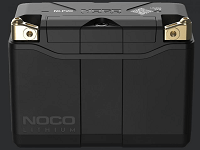
Li-ion type: LiFePO4
BMS: ✔️Dynamic BMS
Capacity: 7Ah (84 Wh)
Starting Current: 600A
Charge Cycles: 2000
Size(LxWxH): 175x87x130 mm
Weight: 1.7Kg (3.7 Pounds)
Medium Capacity
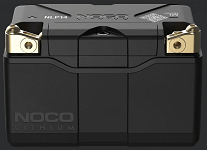
Li-ion type: LiFePO4
BMS: ✔️Dynamic BMS
Capacity: 4Ah (48 Wh)
Starting Current: 500A
Charge Cycles: 2000
Size(LxWxH): 149x87x96mm
Weight: 1.17Kg (2.58 Pounds)
Lightest Weight
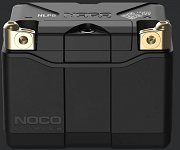
Li-ion type: LiFePO4
BMS: ✔️Dynamic BMS
Capacity: 2Ah (24 Wh)
Starting Current: 250A
Charge Cycles: 2000
Size(LxWxH): 113x70x85mm
Weight: 0.69Kg (1.5 Pounds)
Antigravity Batteries
Antigravity is a company based in the United States that specializes in producing lithium batteries for motorcycles. Their batteries are designed to be lightweight and powerful, making them a popular aftermarket choice for motorcycle enthusiasts.
All of their products are manufactured in California. Antigravity was founded in 2009 and has since become a trusted name in the motorcycle industry.
Largest Capacity
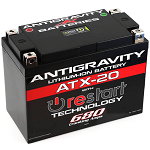
Li-ion type: LiFePO4
BMS: ✔️
Capacity: 10Ah (120 Wh)
Starting Current: 680A
Charge Cycles: 2000
Size(LxWxH): 175x86x130mm
Weight: 1.72 Kg(3.8 pounds)
Medium Capacity
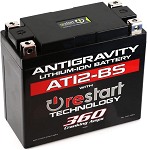
Li-ion type: LiFePO4
BMS: ✔️
Capacity: 6.1Ah (73 Wh)
Starting Current: 360A
Charge Cycles: 2000
Size(LxWxH): 150x70x130mm
Weight: 1.07 Kg (2.35 pounds)
Lightest Weight

Li-ion type: LiFePO4
BMS: ✔️
Capacity: 3.3Ah (37 Wh)
Starting Current: 150A
Charge Cycles: 1000
Size(LxWxH): 114x68x84mm
Weight: 0.6 Kg (1.4 Pounds)
Shorai
Shorai is a China-based manufacturer. I do not recommend using their batteries in Motorcycles since they do not come equipped with a battery management system (BMS).
Without proper overcharge, discharge, and charge balancing, these batteries can be dangerous and may even potentially explode and burn down your motorcycle. It is important to prioritize safety and consider other, safer options that are available on the market.
Largest Capacity
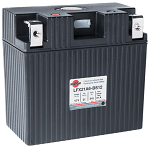
Li-ion type: LifePO4
BMS: ❌ NO
Capacity: 7.7Ah (92 Wh)
Starting Current: 315A
Charge Cycles: 500
Size(LxWxH): 148x82x140mm
Weight: 1.38kg (3.05 pounds)
Medium Capacity
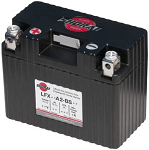
Li-ion type: LifePO4
BMS: ❌ NO
Capacity: 4.4Ah (52 Wh)
Starting Current: 210A
Charge Cycles: 500
Size(LxWxH): 113x58x89mm
Weight: 0.66Kg (1.46 Pounds)
Lightest Weight

Li-ion type: LiFePo4
BMS: ❌ NO
Capacity: 2.2Ah (25Wh)
Starting Current: 102A
Charge Cycles: 500
Size(LxWxH): 113x58x89mm
Weight: 0.42 Kg (0.92 Pounds)
Western Power Sports
Western Power Sports is a US-based company that manufactures products inside the United States. Unfortunately, their Lithium motorcycle batteries do not come equipped with Battery Management System (BMS) so I can not recommend using their batteries in Motorcycles.
Largest Capacity
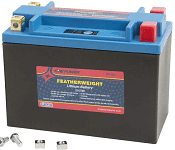
Li-ion type: LiFePo4
BMS: ❌ NO
Capacity: 6Ah (72Wh)
Starting Current: 380A
Charge Cycles: 500
Size(LxWxH): not specified
Weight: 1.65 Kg (3.65 pounds)
Medium Capacity

Li-ion type: LiFePo4
BMS: ❌ NO
Capacity: 4.4Ah (54 Wh)
Starting Current: 290A
Charge Cycles: 500
Size(LxWxH): 152x88x94mm
Weight: 1.08 Kg (2.4 pounds)
Lightest Weight

Li-ion type: LiFePo4
BMS: ❌ NO
Capacity: 2.26Ah (29Wh)
Starting Current: 150A
Charge Cycles: 500
Size(LxWxH): 112x71x86mm
Weight: 0.58 Kg (1.28 pounds)
Aftermarket Lithium battery for Motorcycle Buying Guide
Pros of using aftermarket Lithium batteries for motorcycle:
✔️ Lightweight: Lithium batteries are much lighter than traditional lead-acid batteries, making them an ideal choice for motorcycles where weight is a concern.
✔️ Longer lifespan: Lithium batteries typically have a longer lifespan than lead-acid batteries, meaning they may need to be replaced less frequently.
✔️ Higher energy density: Lithium batteries have a higher energy density, which means they can store more energy in a smaller space. This can be useful for motorcycles where space is limited.
✔️ Faster charging: Lithium batteries can charge faster than lead-acid batteries, which means you can get back on the road more quickly.
✔️ Better performance: Lithium batteries can provide more consistent power output, which can improve the overall performance of your motorcycle.
Cons of using aftermarket Lithium battery for motorcycle:
❌ Cost: Lithium batteries tend to be more expensive than lead-acid batteries, so there may be an initial cost disadvantage.
❌ Compatibility issues: Some motorcycles may not be compatible with lithium batteries, so it’s important to check with the manufacturer or a mechanic before making the switch.
❌ Limited availability: Lithium batteries may not be widely available in all areas, which can make it more difficult to find a replacement if needed.
❌ Special handling requirements: Lithium batteries require special handling, such as not allowing them to fully discharge, in order to maintain their lifespan.
❌ Potential for damage: If a lithium battery is damaged, it can potentially catch fire or explode, which can be dangerous. It’s important to handle them with care and follow all safety precautions.
Self-Discharge rate during Winter Storage
There are several reasons why lithium batteries are better for motorcycle winter storage compared to lead-acid batteries:
- Self-discharge rate: Lithium batteries have a much lower self-discharge rate than lead-acid batteries, which means they will lose charge more slowly while in storage. This can help prevent the battery from losing too much power over the winter months and when spring comes – your bike will start up without a problem.
- Cold weather performance: Lithium batteries are generally more resistant to the effects of cold temperatures than lead-acid batteries. They can still deliver power in cold weather, whereas lead-acid batteries may struggle to deliver enough power to start the motorcycle.
- Maintenance: Lithium batteries require less maintenance than lead-acid batteries and are typically maintenance-free. This can be especially beneficial during winter storage, as it may not be possible to easily access the battery to check the charge or add water.
It’s important to note that both types of batteries can be used for motorcycle winter storage, but lithium batteries self-discharge at 2% per month and lead-acid at 30% per month. Meaning that the lead-acid battery will be dead when spring comes if winter storage is longer than 3 months.
How to upgrade a motorcycle from lead-acid to Li-ion battery?
To get started, you will need to choose a lithium-ion battery that is the right size and shape to fit in your motorcycle.
Measure the dimensions of your current lead-acid battery and use these measurements to find a compatible lithium-ion battery. Choose the same dimensions or a smaller battery. You can always add some foam to compensate for the smaller battery size and fixate the battery inside battery-box. Moreover, remember that Li-ion batteries may be put on the side or even upside down unlike lead-acid which makes the installation easier.
Do I need a Battery Management System (BMS) in Li-ion battery?
Replacement lithium-ion batteries must have a built-in battery management system (BMS). A BMS helps to regulate the charging and discharging of the battery, ensuring that it performs optimally and does not become damaged.
For example, Shorai and Western Power Sports batteries do not come equipped with BMS. Which reduces battery life from 2000 cycles to 300-500 cycles since batteries get out of balance without BMS very fast. Also, without overcharge and over-discharge protection Li-ion batteries get damaged quickly. BMS cuts power to the battery if it is fully charged stopping further battery charging which will damage Li-Ion battery.
What Starting Current Should the battery provide for my motorcycle?
This depends on the engine displacement and other engine parameters like compression. Another factor is how cold it is outside – if the temperature is around 0 degrees Celsius and the engine oil is cold – it will be harder for the starter to crank the engine with the necessary for start-up speed. A bigger capacity battery that is capable of providing higher cold cranking amps (CCA) is better in such cases.
In general, a motorcycle battery should be able to provide at least 200 cold cranking amps (CCA) to start the engine. I would choose at least 250CCA for engines up to 500cc displacement and 500CCA for larger engines.
It is important to check the owner’s manual or consult with a mechanic or manufacturer to determine the appropriate CCA rating for your specific motorcycle.
The Bottom line
In conclusion, it is important to choose a Lithium battery with a Battery Management System (BMS) to ensure the best performance and longevity. The CCA (Cold Cranking Amps) rating should also be taken into consideration when selecting a battery, with larger capacity engines requiring a higher CCA. NOCO and Antigravity are both highly reputable manufacturers, with a range of options available for different engine sizes and types of motorcycles. It is recommended to consider the specific needs and capabilities of your motorcycle when choosing a battery and to carefully review the product details and specifications provided by the manufacturer.
